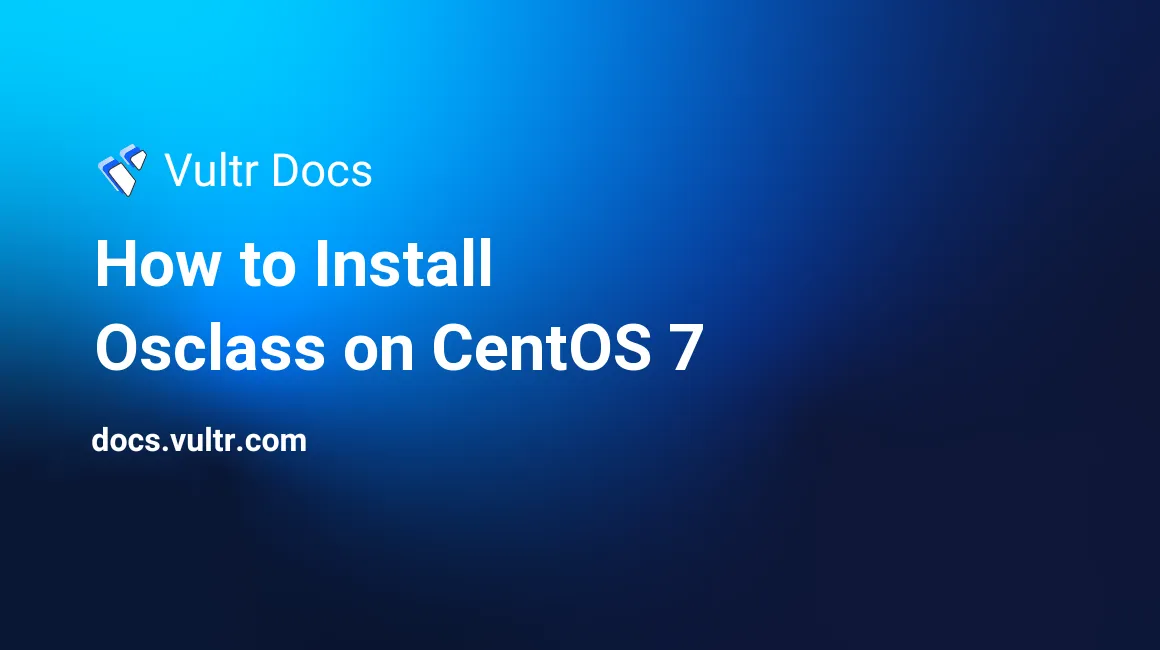
##Introduction Osclass is an open source project that can be used to create and manage your own classifieds website without any technical knowledge. It is fully customizable and allows you to create a site with real estate ads, job listings, car classifieds, and rentals using dozens of templates, themes, and plugins.
In this tutorial, you will learn how to install Osclass on a CentOS 7 server.
##Prerequisites
- A Vultr CentOS 7 server instance.
- A sudo user with root privileges.
##Step 1: System update Before starting, you will need to install the EPEL repository and update the system to the latest stable state.
sudo yum install epel-release -y
sudo yum update -y
sudo shutdown -r nowOnce the system has rebooted, you may proceed to the next step.
##Step 2: Install LEMP server Install Nginx, PHP, MariaDB and other required modules on your system. Install them by running the following command:
sudo yum install nginx mariadb mariadb-server php php-mysql php-gd php-ldap php-xml php-xmlrpc php-mbstring php-mcrypt curl zlib -yOnce the installation is complete, start Apache and MariaDB service and enable them both to start on boot:
sudo systemctl start nginx
sudo systemctl enable nginx
sudo systemctl start mariadb
sudo systemctl enable mariadb##Step 3: Configure MariaDB for Osclass
First, you will need to improve the security of your MariaDB installation and set your MariaDB root password. You can do this by running the mysql_secure_installation script:
sudo mysql_secure_installationAnswer all of the questions as shown below.
Set root password? [Y/n] y
Remove anonymous users? [Y/n] y
Disallow root login remotely? [Y/n] y
Remove test database and access to it? [Y/n] y
Reload privilege tables now? [Y/n] yLog into the MariaDB console and create a blank database for Osclass:
mysql -u root -pEnter your MariaDB root password and hit enter, then create a database for your Osclass installation:
MariaDB [(none)]>CREATE DATABASE osclassdb;
MariaDB [(none)]>CREATE USER 'osclass'@'localhost' IDENTIFIED BY 'password';
MariaDB [(none)]>GRANT ALL PRIVILEGES ON `osclassdb`.* TO 'osclass'@'localhost';
MariaDB [(none)]>FLUSH PRIVILEGES;
MariaDB [(none)]>\q##Step 4: Install Osclass
First, you will need to download the latest version of the Osclass from the official website. You can download it with the wget command:
wget https://static.osclass.org/download/osclass.3.7.1.zipOnce the download has finished, unzip the Osclass archive to the apache web root directory:
sudo mkdir /var/www/html/osclass
sudo unzip osclass.3.7.1.zip -d /var/www/html/osclassNext, change permission of the osclass directory:
sudo chown -R nginx:nginx /var/www/html/osclass##Step 5: Configure Nginx for Osclass You will need to create an Nginx virtual host for your Osclass website.
sudo nano /etc/nginx/conf.d/osclass.confPopulate the file with these lines:
server {
listen 80;
server_name yourdomain.com;
location / {
root /var/www/html/osclass;
index index.html index.htm;
}
error_page 500 502 503 504 /50x.html;
location = /50x.html {
root /var/www/html/osclass;
}
}Save and close the file, then restart the Nginx service for the changes to take effect.
sudo systemctl restart nginx##Step 6: Access Osclass web interface
Before accessing the Osclass web interface, you need to allow the Apache port 80 through firewalld.
sudo firewall-cmd --permanent --add-port=80/tcpReload the firewall service for the changes to take effect.
sudo firewall-cmd --reloadFinally, open your favorite web browser and navigate to the URL http://your-server-ip/index.php or http://yourdomain.com/index.php. Complete the required the steps to finish the installation.
No comments yet.